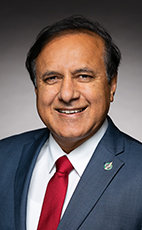44th Parl. 1st Sess.
May 18, 2023 10:00AM
- May/18/23 10:46:21 a.m.
- Watch
Mr. Speaker, I will be sharing my time with the member for Sherbrooke.
Before I begin my speech, I want to acknowledge that I am rising today in Ottawa, which is on the traditional unceded territory of the Algonquin Anishinabe people, who have lived on this land since time immemorial.
It is important that we take the time today to address this national public health crisis, but first, however, I want to talk about the wording of the motion we are debating today.
The opposition is calling on us to reverse deadly policies, yet the BC Coroners Service has repeatedly said that there is no indication that the prescribed safe supply is contributing to the drug deaths from the illicit drug supply. It seems that the Conservative Party wants to take us back to the failed ideology of the Harper-era drug policies. Assez, c'est assez.
Why can the opposition members not understand the harm that their narrative is causing. The member talks about zombies and talks about crazy policies. This is stigmatizing, and that is all they know how to do. Do they not hear the public outcry from people who actually have lived and living experiences with substance use, the people who have overdosed two and three times and have been revived at a safe consumption site and are now part of helping people get well?
Groups like Moms Stop the Harm, who have are the loved ones of people who have lost lives to overdoses and toxic drug supply, have asked the Leader of the Opposition to meet with them in early June. Will he meet with them and hear their story? It changes people's lives and their opinions.
This fight against evidence-based programs that are actually saving lives just has to stop. People are dying but not for the reasons they are giving.
Canada is facing a twofold epidemic: a toxic and illegal drug supply and an overdose crisis.
Every day, countless lives are shattered by the devastating consequences of the crisis and over 30,000 people have died.
We must recognize that substance use and addiction are two complex problems that we cannot resolve by simply ignoring them or using outdated approaches.
Families mourn the loss of their loved ones. Communities bear witness to the tragedy of addiction, and the individuals suffer often in silence because they are being stigmatized, as the opposition is doing today. It does not have to be this way. Substance use disorder, opiate use disorder, is a recognized, chronic medical condition that deserves the same respect and evidence-based care as any other illness.
By implementing safer drug supply initiatives, we can save lives and provide individuals with the opportunity to break free from the cycles of addiction, because there is no recovery for people who are dead.
We have to be there. When the person using drugs asks “where is the suboxone lady”, we need that absolutely real-time approach.
It is by implementing safer supply that we minimize the risks of people using drugs. We can ensure that those who use drugs have access to pharmaceutical-grade substances that are tested for potency, purity and prominence. It is the poisoned drug supply that is killing people. The opposition needs to understand that this is the problem we are dealing with, this toxic drug supply.
We can prevent accidental overdoses caused by drugs with unpredictable potency, contaminated substances or adulterants.
We can save lives; we must save lives. However, our approach goes beyond saving lives. It is about creating the path to recovery and rebuilding shattered lives and families.
When individuals have access to safer drugs, they engage with the health care professionals. They are able to seek support, healing and rehabilitation. It is like moving from Insite to Onsite in Vancouver. It provides an opportunity for connection, trust and the delivery of comprehensive care.
I want to be clear that this is not about encouraging drug use or turning a blind eye to the consequences. It is about acknowledging the reality that people will continue to use drugs and that by providing a safer alternative, we can minimize the harm and pave the way toward recovery and rehabilitation.
Illegal drugs being sold illegally is still illegal. Diversion is illegal.
We need to recognize that, behind the statistics and the headlines, there are real people who have dreams but are struggling. They deserve our empathy, our understanding and our support. Stigmatizing people who are battling a substance use problem and criticizing the care they receive will not help them seek treatment.
What is more, Canadian drug policy and international drug policy are aligned. Prevention, harm reduction, treatment and enforcement make up the four internationally recognized pillars of drug policy.
We lived through 10 years of that Conservative government taking harm reduction out with its deadly war on drugs, and that has been proven to be ineffective, costly and deadly. These policies have also had a profound negative effect on Canada's most vulnerable, including indigenous people, children, young people, people living with disability, and immigrants and refugees.
While the Conservatives continue to try to take us back to the days when substance users were told that their lives did not matter, our government is using every tool at its disposal to put an end to this national public health crisis.
I would like to quote from the public safety and justice adviser to former prime minister Stephen Harper, Ben Perrin, who said, “Safer supply has been tested and found to be beneficial for people who have been unable to have treatment for whatever reason, and are long-term substance-abuse users. We’re talking about essentially substituting a contaminated street drug with a drug that has known contents and potency to help people stay alive, first of all, and also to be able to stabilize.”
Here is what some other important experts have said. Both the College of Physicians and Surgeons of BC and the College of Physicians and Surgeons of Ontario have made statements acknowledging safer supply is a harm reduction tool to support people with opioid use disorder.
I encourage the member to reread the CMAJ article from last September and see that on safe supply, the community health centre is providing the suite of health and social services reports. That is exactly what we do. It is exactly how we get them in the door so they can find a way to a better life.
As I continue to say, since 2017, safe consumption sites in Canada have received more than 4.1 million visits, reversed 46,000 overdoses and made 236,000 referrals to health and social services, which the Conservatives have vowed to defund.
What do we say to the families of those who would have died if this approach had not been offered to people who use drugs? If only I could say that this is the first time the Conservatives have not followed public health advice.
Unfortunately, this is the pattern for the official opposition. Despite overwhelming support and effectiveness of vaccines and despite the fact that 11% of maternal deaths are from unsafe abortions, that party continues to prefer ideology over evidence. We, as a country, must and can do better. I prefer the Canadian Medical Association Journal to the National Post. More important, this is how we will save lives.
1238 words
- Hear!
- Rabble!
- add
- star_border
- share
- May/18/23 3:01:57 p.m.
- Watch
Mr. Speaker, let us talk about the Conservative Party's pollution pricing flip-flop. In 2007, the Harper government proposed a $15 carbon tax. In 2008, that same government promised to introduce a cap-and-trade system. In 2011, the Conservatives ditched that idea along with every other climate measure. During the 2021 election campaign, they once again supported carbon pricing.
Can the Minister of Environment and Climate Change tell the House about the ambitious climate measures our government is proposing to—
83 words
- Hear!
- Rabble!
- add
- star_border
- share
- May/18/23 5:02:45 p.m.
- Watch
Mr. Speaker, as everyone sitting in this House knows, the toxic drug supply and overdose crisis is devastating communities throughout Canada. We are losing 20 Canadians a day. Prior to COVID, 10 people were fatally overdosing every day in Canada, but now it has increased. Many more of our friends, family members and community members are being hospitalized, calling emergency support for services and grieving lives lost over the past seven years of this crisis.
Unfortunately, we are now debating a misguided motion rooted in outdated ideology that will recycle a discredited, narrow approach rather than create a comprehensive plan to deal with a crisis that is killing people. Even former prime minister Stephen Harper's public safety adviser, Benjamin Perrin, has seen the light and describes the current Conservative approach, which is epitomized by this motion, as “rehashing Conservative, war-on-drugs tropes that have been long since discredited and have been found to be not only ineffective, but costly and deadly.”
There are four pillars recognized internationally that are necessary for a successful substance use strategy: prevention, treatment, enforcement and harm reduction, including a safer supply. In December 2016, our government launched the Canadian drugs and substances strategy, which uses a public health approach to substance use. In doing so, we committed to a comprehensive, collaborative, compassionate and evidence-based drug policy.
Under the Canadian drugs and substances strategy, the Government of Canada has taken evidence-based action to address the toxic drug supply and overdose crisis and has announced over $1 billion in funding. This funding includes $490 million through Health Canada's substance use and addictions program to support community-based treatment, harm reduction, prevention, and stigma reduction activities. In addition, this funding has supported research and surveillance initiatives and strengthened law enforcement capacity to address illegal drug production and trafficking. Going forward, the Canadian drugs and substances strategy will continue to guide our government's drug policy approach, which includes a full continuum of evidence-based options, as well as innovative life-saving strategies to meet people where they are and provide them with the supports they need.
Substance use is an extremely complex issue, and Canadians use drugs for a multitude of reasons. Not everyone who uses drugs is suffering from an addiction. Even when a diagnosis exists, treatment services may not be available or affordable. Moreover, not everyone is always willing, eligible or able to enter treatment. Recovery looks different for everyone. Services to keep people alive and safe and that support better health outcomes should not be limited to just treatment services for people with a formal diagnosis of a substance use disorder, given the crisis is affecting people trying drugs for the first time, people who use drugs occasionally and people who are struggling with an addiction in silence.
There is no one-size-fits-all solution to this crisis. We need a range of interventions that meet people where they are and reduce the potential harms related to substance use. Harm reduction is a key element of that work and this government's strategy to address the toxic drug supply and overdose crisis.
Evidence has shown us that harm reduction measures, such as supervised consumption sites, in-person or virtual spotting services, safer supply, take-home naloxone, and drug-checking technologies, are supporting people who use drugs by connecting them to health and social services and, most importantly, are keeping them alive. For example, in one of the hardest hit provinces, evidence in British Columbia has shown that the combined effect of expanded access to take-home naloxone programs, supervised consumption sites and opioid agonist treatment has been crucial to averting overdose deaths in the province. In addition, between 2015 and 2021, nearly 125,000 naloxone kits were used to reverse an overdose in B.C.
In 2016, there were only two supervised consumption sites in Canada, both in Vancouver. Since then, the number of federally approved supervised consumption sites offering services has grown to as high as 40, and they are available in British Columbia, Alberta, Saskatchewan, Ontario and Quebec. This is because we are investing in what works and where the evidence is. At these sites, more than 46,000 overdoses have been reversed, and there have been over four million visits. That is a point worth repeating.
The safe consumption sites the Conservative leader wants to shut down have reversed more than 46,000 overdoses since 2017. When we say that harm reduction meets people where they are, this is what we mean. These harm reduction services are saving lives every day. Spotting services support someone who is using drugs either in person or remotely by phone, video chat or an app, and they provide help in case an overdose occurs.
During the first 14 months of operations, the virtual national overdose response service monitored over 2,000 substance use events and responded to over 50 adverse events. These events required an emergency response and no fatalities were reported.
Although the Conservative opposition will tell us otherwise, harm reduction efforts are not antithetical to treatment. They are part of the continuum of care. They meet people where they are, and they can connect people with a spectrum of health and social supports.
877 words
- Hear!
- Rabble!
- add
- star_border
- share
- menumenu
- notificationsnotifications
- home
- mailmail
- searchsearch





